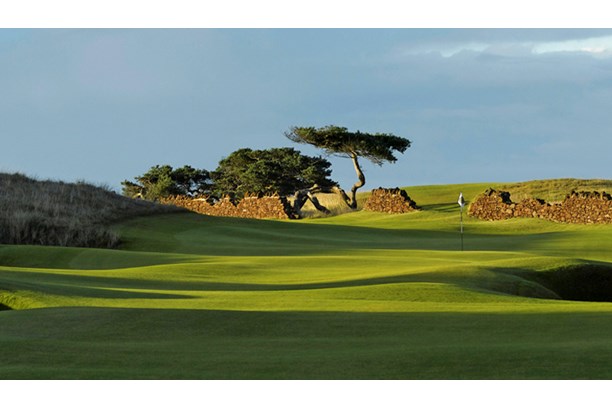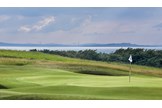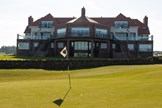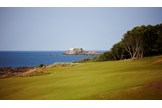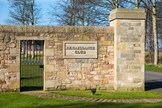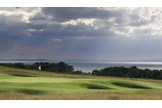The Renaissance Club
Last updated:
What we say
The Renaissance Club came with huge expectations, which explains its somewhat mixed reception. Judge it on its own merits, though, and it will be one of the best golf courses you play all year.
Fame carries with it a heavy weight of expectation in every facet of life but especially in creative genres where success is inexorably subjective. Stellar reputations help secure jobs, contracts and commissions, but bring with them enormous pressure to succeed.
That burden sits on Tom Doak’s shoulders every time a spade enters the ground on his next project, whether that be a new course or a renovation. With a CV embossed by World Top 100 staples Pacific Dunes, Barnbougle Dunes and Cape Kidnappers – in addition to well-established acerbic analysis of his peers’ work – the engaging American must feel the heat with every piece of work.
If you then add a coastal site in the ‘Home of Golf’ – close to where he was based during his year studying the classics of GB&I that so influenced his philosophy – the flame rises a little higher.
RELATED: Muirfield Golf Club review
The temperature further increases when the course he is building is then named after his own architecture firm.
That was the scenario at the end of the last decade when Doak created The Renaissance Club in East Lothian, arguably Scotland’s most well-endowed golf area. It is the backstory against which the course has been, and will always be, judged.
TRC is even juxtaposed to storied Muirfield, which Doak has suggested is one of his 10 best courses in the world, and is 20 minutes from another of his favourites, the fabled West links of North Berwick.
The 300-acre site was however different from those feted links – and indeed the likes of Oregon’s Pacific Dunes and Barnbougle Dunes in Australia. Previously dominated by sycamores and pines and with, in the construction phase at least, little land on the edge of the coast, Doak’s task was to maximise the potential of links land that is more gentle than some of the truly outstanding sites he has enjoyed elsewhere.
“That site was not what you might expect in that area,” he told me when I met him at Woodhall Spa, whose Hotchkin course he renovated from 2018.
“It was very different from other properties in the area because of the trees and lack of dunes, but as well as being sandy, the land has beautiful subtle movement.”
He adapted to the task with predictable ease, creating adventurous green complexes to contrast with what is nicely flowing but largely unspectacular terrain.
The site’s agronomy was more predictably helpful, being covered in sand that is useless to basically anything other than the kind of fine grass species harmonious with the fast-running style Doak champions. At TRC it hosts pure red fescue that gives it the look and playing characteristic of other modern links such as Kingsbarns and Castle Stuart. Some understandably prefer a more seasoned look to seaside turf, but this tight-knit but delicate sward appeals to this golfer. It takes years to look, and more importantly feel, properly bedded in. However a decade after opening, at TRC there is certainly the enjoyably crisp thud with a compressed iron shot and a precision and assurance with which chips can be struck.
It goes without saying Doak has left firm surfaces and the relative lack of bunkers (and obviously no water) at the front of greens, mean the ground game – that aficionados love and the less skilled can be thankful for – is an option for virtually all of the round.
The bunkering, indeed, feels notably forgiving, affecting usually only those seeking reward for a more expansive tactic rather than the rest of us simply trying to manoeuvre our way round a course that has championship length at 7,300 yards off the tips yet can be compressed down to 5,400 without forfeiting nuance. That is, one might suggest, the excellence in strategy and flexibility you get from one of the world’s leading architects.
RELATED: North Berwick Golf Club review
So, while it is playable and enjoyable for higher handicaps off sensible tees, it hosted the British Boys Amateur Championship in 2016, became a Final Qualifying venue for the Open Championship in 2018 and has hosted the European Tour’s Scottish Open.
Indeed, while the spectacular views of Castle Stuart – by Doak protege Gil Hanse – are largely missing at TRC, there are similarly wide playing areas and an emphasis on playing angles.
Doak bequeathed a terrific set of green complexes to TRC; they are as varied as they are entertaining. My lasting impression of the surfaces was that they generally looked much more severe than they played. This was only my second experience of a Doak course, after Cape Kidknappers in New Zealand 13 years ago, and it might be the case I was expecting more severity given his reputation for the extreme.
The routing has however altered from when it first opened in 2008. There was always the possibility of land by the Forth being acquired and granted consent during the original routing process but it was not guaranteed. However when it was secured, from The Honourable Company of Edinburgh Golfers, it was understandably hard to resist incorporating that sort of spectacular landscape, especially as it wasn’t going to overtly compromise the routing. That said, I know of golfers who played the original course and mourn the loss of the opening trio that are now used as practice holes.
I have seen those three holes but did not play the initial routing. However the three new coastal holes are strong and getting down by the water in the way they permit adds a welcome dimension.
The new configuration saw the 11th remain the same hole but become the 8th, with the current 9th and 10th fitted into the land beyond that. The old 12th and 13th holes were taken apart and put back together into a single par 4 that plays to the old 13th green. The 16th was lengthened to a par 5, following on from a new par 3 that was inserted between the old 15th and 16th.
RELATED: Golf World Top 100 Courses in Scotland
There is always a feeling of space at TRC and that is rarely more obvious than on the opening holes that stretch in different directions through copses of spindly firs that do not compromise the playing area.
It is gentle but classy start and the first time the sea is viewed is on the tee of the short 6th, after which the stand-out holes in the opening nine come back-to-back at 7 and 8. The first is a strong par 5 with an undulating fairway and an obscured approach to a compelling green in the vain of an historic west coast Irish links among big dunes. Tucked on a shoulder behind a wild hump, you’ve got to be brave and adventurous to hold the green, or everything will kick way left below the green, leaving a fun but tricky up and down.
Then the epic two-shot dog-leg 8th encompasses a fabulous green, climbing elegantly between a high dune and a tumbling original drystone dyke which Doak has beautifully incorporated into the experience, along with a lone pine. He has added four bunkers to the idyllic scene.
The first of the new holes, the 9th is a seaward-looking but exacting par three to an ‘infinity’ green slouching against a wall before a super sporty 4 that plays across the edge of the cliffs but toward a shaggy bank on the other side; the epitome of a strategic hole where angles are everything.
A gentle walk up the hill offers chance to take in the views and assess the experience thus far before tackling another fine par 3. The new long par-4 12th rises to the course’s high point and is followed by an attractive par 5 to a dell green.
After the tough 14th, the new 15th – a short hole to a plateau green close to the clubhouse – is followed two holes later by another fine par 3 with a tiered green set between sand hills before an exacting finish that includes a drystone dyke, probably a headwind and an undulating green.
Well before this hard-working climax you will have made your mind up about Doak’s work and whether it lives up to his reputation. It might be that you had exaggerated expectations given his reputation, and if that is the case the quiet excellence of TRC may struggle to live up to them.
If pre-round expectations are sensible, it is likely this subtle and classy modern links will leave most golfers satisfied, and convinced Doak can handle the pressure to create something special.
READ NEXT: Golf World Top 100 Links Courses in Great Britain and Ireland
-
Course Summary
- Costs -
- TG Rating
- Players Rating
- Address The Renaissance Club, Cowden Hill Drive, Dirleton, North Berwick, East Lothian, North Berwick
- Tel 01620 850901
- Website http://www.trcaa.com/
Course Information
| Course | 71 par |
| Course Style | - |
| Green Fees | - |
| Course Length | 7,300 yards (6,675 metres) |
| Holes | - |
| Difficulty | - |
| Course Membership | - |
Course Features
- Course has: Bar
- Course has: Buggy Hire
- Course has: Driving Range
- Course has: Practice Green
- Course has: Pro Shop
- Course has: Restaurant
- Course has: Trolley Hire
- Course does not have: Dress Code
- Course has: Club Hire
- Course has: Handicap
Your Reviews
-
Great Course
Not sure I like the idea of a very expensive, very exclusive, American style club on Scottish soil but the course itself is fantastic. The new holes at the turn are a spectacular addition to a very solid layout. Interesting green complexes without being too extreme like a few greens on the Castle or Mach Dunes. I've played all of the top 60 and I would rank TRC in the top 30.
-
The Renaissance
Was fortunate enough to play here at a member guest competition on a glorious day in June. Course was in fantastic condition but with brutal rough - apparently in order to raise the slope rating for the USGA. Not true links but links like enough in ground undulation, quality and tight lies to play in that style. Not sure why there is a cross against dress code as golf attire was fine throughout the superb clubhouse. A very enjoyable and fair test of golf there are many scenic holes and the new 10th is fantastic and up there with any of the new links I've played and keen on the heels of the Ailsa etc. Not snooty or over pampered (like Loch Lomond) it is such a shame that there are not more members / opportunities for 'regular' golfers to play. In spite of the USGA's slope antics I felt that this was a more stern test than Kingsbarns and definately of the calibre to hold a European Tour Event.

